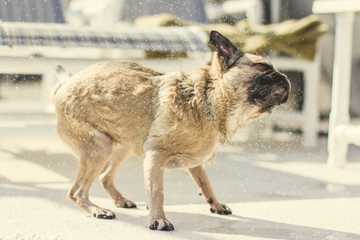How to Stop a Dog from Shivering When It’s Cold

Por
Anastasiia Petrovska Actualizada en |Revisado por Shannon Kenny
When you see your dog shivering in the cold, it’s natural to feel worried. Wondering how to warm up a shivering dog is a common concern for dog parents during the cold season. It’s even more essential to know how to do that safely, without causing harm.
Puntos clave
- Shivering can be a sign of cold, stress, or illness
- Move your dog to a warm place as soon as possible
- Drying your dog quickly helps restore normal body temperature
- A warm bed and blankets can help stop shivering
- Contact a vet if shaking continues for a long time.
Below you’ll find 10 effective ways to stop a dog from shaking. This guide also offers an explanation of why it can happen. Continue reading to find actionable recommendations on how to warm up your pet safely and avoid potential health problems.
How to Stop a Dog from Shaking
Shivering is normal when it happens occasionally, but it can also be a sign of fear, stress, or even hypothermia. Try to rule out the potential cause of shaking, whether it’s fear, stress, or a cold. In case of the latter, dog owners need to act immediately.

Explore other potential reasons for shaking below. Learn about the warning signs that may suggest your dog has hypothermia. Each of these recommendations is safe, easy to follow, and vet-approved.
1. Bring the dog indoors
The first thing you need to do when you see your dog shaking is to bring them inside. Low temperatures deplete body heat fast, with small, short-haired breeds suffering more. Elderly dogs are also more likely to shiver during cold weather. If you’re wondering, “What should I do if my dog is trembling when we’re outside?” start by getting indoors.
When it’s cold, even your porch or a garage is a better option than staying outside. Reducing exposure to extreme temperatures or wind will help your pet’s body temperature stabilize.
Make sure to check if your dog shows the following signs of a cold:
- Refusing to walk or moving too slowly
- Curling up tightly and hiding the nose
- Whining
- Lifting paws off the ground
- Ears or body cold to the touch.
If your dog is trembling and you see the following signs, bring the dog indoors as soon as possible.
2. Dry the dog
Moisture collected in fur significantly increases heat loss. When your dog is wet because of snow, rain, or even a bath, you need to dry them quickly with a towel. Experts from the Open University warn that damp fur can’t go through the thermoregulation process properly, as it lowers a dog’s temperature.
Towels made from absorbent fabric are essential to remove as much moisture as possible. It’s one of the fastest ways to get your dog to stop shaking from the cold. Also, it’s one of the quickest methods to retain body heat.
3. Wrap in blankets
Wrapping your dog in thick, warm blankets is the first thing that comes to mind when your dog is shivering. This method is quite effective in raising body temperature, especially for dog owners who are not sure what to do at night or after long winter walks.
Fleece blankets are the best choice, as they save heat without adding extra weight. If you need to, you can wrap the dog in several layers.

If you keep struggling to stop a dog from shaking if they don’t like being wrapped, keep the blankets loose and let them burrow inside. If the dog isn’t used to blankets, don’t leave them unsupervised. They can rip it and ingest the pieces or even suffocate with them.
4. Ensure a draft-free area
Cold drafts from doors and windows can definitely make things worse. Thus, bring your dog to a warm, comfortable room for a proper rest. This tip is essential if you need your dog to stop shaking while inside. Blocking all the drafts helps to improve body temperature and prevents heat from leaving the dog’s body. Don't allow your dog to stay on concrete or tile floors – they tend to absorb the heat quickly.
5. Encourage your dog to move around
Make sure you encourage your dog to move around when you’ve dried them and warmed them up with the blankets. A little fun and play won’t just bring a little joy, but also help warm up your dog.
6. Use warm water bottles
Warm water bottles provide a stable and pet-friendly source of heat. Before placing them beside the dog, wrap the bottles in the towel. This way, you can avoid getting burns. The belly or back is the perfect spot to place the bottles.
Make sure not to lay warm water bottles under the dog to avoid overheating. Replace the bottles and fill them up with warm water again to keep the dog warm consistently. Monitor your dog’s state and overall behavior to avoid overheating.
7. Provide a warm bed
A soft, warm bed will help retain body heat better.

Dog beds with high edges can stop your dog shivering from drafts, while orthopedic beds are crucial for older dogs with mobility issues. A self-warming dog mat will be a valuable addition to the bed. Small dog breeds or young puppies tend to lose heat faster than other dogs, which is why extra bedding might be useful.
8. Offer warm fluids
If you’re not sure what to do when your dog is shivering, warm, low-sodium broth or slightly heated water are a must for a shivering dog. They encourage your dog to drink while supporting blood circulation and maintaining a stable body temperature. Alone, it might not be the most effective way to warm up a shivering dog, but it improves other warming methods.
9. Avoid direct heat sources
Even if your dog seems cold, never place them directly beside a fireplace or a heater.

Pets may have reduced sensation from cold, which increases the chance of getting burns. It’s an essential reminder for all pet owners: gradual and gentle warming is the best option for a dog shaking from the cold.
10. Monitor their condition
When you’ve warmed up the dog, make sure to monitor them closely, in particular:
- Their mood
- Body temperature
- Appetite
- And overall behavior.
In case the shivering continues for more than an hour or if other symptoms appear, such as increased sleepiness, refusal to drink, or lethargy, contact a vet immediately.
According to vet reports, paleness of the gums, difficulty walking, or confusion, paired with long-lasting shivering, can be a sign of hypothermia and require immediate help.
Dog Shaking: Other Causes
Even though this guide provides recommendations on how to stop a dog from shaking due to cold, shaking in dogs can also result from:
- Stress
- Anxiety
- Poisoning
- Fever
- Injury.
See a veterinarian for a full examination, especially in the presence of additional symptoms.
Dogs may shake for reasons other than the cold. Learning to read your dog’s body language will help you understand what they're trying to communicate. The faster you know, the easier it will be to help.
Wrap up
Knowing how to stop a dog from shaking is essential for cold seasons, as it can help to prevent serious health problems. By following simple steps, such as bringing your dog inside and drying them, providing a warm bed and blankets, you can warm them up safely.
In case you’ve tried all the recommendations and nothing worked, see a veterinarian to avoid serious medical conditions. By using these easy and practical steps, you can protect your pets from cold-related risks and maintain their long-term health.
